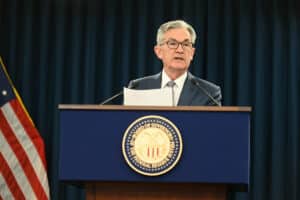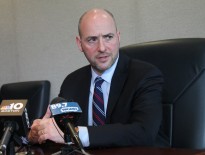
Federal Reserve Chair Jerome Powell speaks at a news conference following the March 3, 2020 Federal Open Market Committee meeting. Photo courtesy of the Federal Reserve
The Federal Reserve signaled Wednesday that it will keep its key short-term interest rate near zero for the foreseeable future as part of its extraordinary efforts to bolster an economy that is sinking into its worst crisis since the 1930s
The Fed said it will also keep buying Treasury and mortgage bonds to help keep rates low and ensure that companies can continue to lend easily to each other amid a near-paralysis of the economy caused by the coronavirus. It did not specify any amounts or timing for its bond purchases.
“The Federal Reserve is committed to using its full range of tools to support the U.S. economy in this challenging time,” the central bank said in an unusually sweeping declaration at the top of its statement.
The Fed’s policy statement also said the viral outbreak and measures to contain it are “inducing sharp declines in economic activity and a surge in job losses.”
Widespread business shutdowns have caused roughly 30 million workers to lose jobs over the past month and a half. As layoffs mount, retail sales are sinking, along with manufacturing, construction, home sales and consumer confidence.
During two emergency meetings in March, the central bank cut its benchmark rate to a range between zero and 0.25 percent. It has also announced nine new lending programs to pump cash into financial markets and provide support to large and medium-sized businesses as well as cities and states.
The Fed’s statement Wednesday came on the same day that the Commerce Department released grim news about the economy: Economic output shrank at a 4.8 percent annual rate in the first three months of the year – the worst showing since the Great Recession struck near the end of 2008.
The economic picture is expected to grow ever darker, with the economy forecast to contract at a shocking 30 percent to 40 percent annual rate in the April-June quarter. The unemployment rate could reach 20 percent when April’s jobs report is released next week.
Chairman Jerome Powell is holding his usual news conference, this time virtually, rather than on site. Powell will likely fill in details on some of the nine lending programs the Fed has launched to try to aid the economy and to keep rates low in the face of the coronavirus-induced downturn.
The central bank has already slashed its benchmark interest rate to near zero and escalated its purchases of Treasury and mortgage-backed securities to pump cash into financial markets to smooth the flow of credit. It has also said it will buy corporate bonds and lend to states and cities – two actions it has never previously taken.
“The fact that they are operating in those markets is unprecedented,” said Nathan Sheets, chief economist at PGIM Fixed Income and a former director of international finance at the Fed. “They are coming up on the extent of their legal authorities here.”
As economic activity has collapsed, inflation has also begun to fall. Economists expect it to drop below 1 percent by next year, far under the Fed’s 2 percent target level. That poses another problem for the Fed: Declining prices can eventually lead consumers to delay spending, thereby slowing the economy further.






